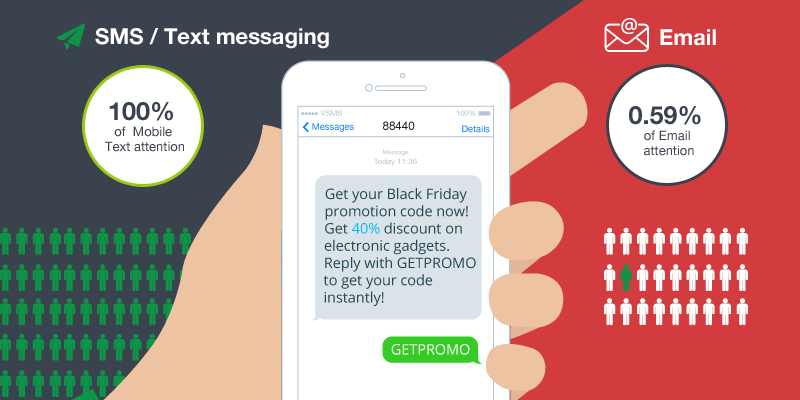
Scarce Resources and SMS
When attention is scarce, SMS is the solution
Here’s the one crucial fact for anyone in business: we are drowning in information.
Essentially, our brains have the same computing power as they had just before the Gutenberg press. Yet the data we have to crunch daily has exploded. Something just has to give. And In this case, it’s attention. We are all experiencing a scarcity of attention.
According to a study by Martin Hilbert, the quantity of two-way communication done by people daily – that includes phone conversations, email and messaging apps – has gone from the equivalent of two newspaper pages in 1986 to twenty entire newspapers in 2010.
What does this scarcity of attention mean for business? Start by taking an honest look about how much information you are currently bombarding your potential customer with. Unfortunately, there’s a tendency for one-upmanship. If your biggest rival sends out X information, you send out X+Y to compete.
And that means you’re a big part of the problem. This ‘infoxication’ makes efficient decision making impossible. So your potential customer simply freezes – does nothing.
It’s why you may hate your bank…but you don’t switch. Or why you blindly renew your mobile phone contract every two years. The status quo is the easy option. But the status quo is your enemy if you’re trying to get people to switch, trial or buy.
Let’s take a real-life example: last Black Friday I received 167 sales emails in my personal inbox. All from companies I’d purchased from over the years. Let’s just imagine for a moment that instead of trashing before reading, I instead opened them all. It would have meant that each company would have received exactly 0.59% of my email attention.
Is 0.59% of someone’s attention enough to get them to perform the action you want them to? If it’s about getting them to open their wallet, almost certainly not.
What’s the alternative? B.J. Fogg – Professor at University of Stanford – models human behaviour. In short, he is a world-leader on persuasion, social influence and nudging people to make better decisions. It was Fogg who invented the phrase: “persuasive technologies.”
Fogg’s key focus is the mobile phone. He believes the mobile, by being location-specific, contextual, timely and immediate, is simply the greatest persuasive technology device ever invented. Let’s take a closer look at persuasive mobile technologies…
First, the push notification. Believe that they’re the future? Consider this: as the overall use push notifications increases, the rate of push notifications driving app engagement lowers.
Brand Quarterly estimates that half of app users opt out of push notifications when installing an app – immediately diminishing your audience reach by half. And a report from Accengage shows that only 6 per cent of push notifications directly lead to a user opening an app.
Wave after wave of push notifications have created a scarcity of attention usually associated with email. In a word, overload.
The alternative? SMS / text messaging.
On the same day I received 167 Black Friday emails, I received one Black Friday promotional SMS. That company enjoyed 100% of my mobile text attention. And SMS is quality attention. Here’s why:
- 91% of adults keep their smartphones within arm’s reach
- 97% of people open a text within 4 minutes of receiving it
- 19% of people will click the URL in an SMS, compared to just 4.2% for emails
- 57% of consumers would consider opting into a brand’s SMS loyalty programme
- 30% is the average response rate from SMS campaigns. Email campaigns? Just 4%
In an ever more crowded world, SMS offers you an attention-grabbing medium with unparalleled cut-through.
How does your business currently utilise ‘the greatest persuasive technology device’ at your entire company’s disposal? Just how much SMS attention are you grabbing?
Attention is scarce. Money is made from scarcities. And the most prosperous people are those who notice scarcities first. Operating in a market where everyone is competing for too little attention? Grab the lion’s share with SMS.
To take full advantage, talk to the bulk SMS marketing experts. Contact VoodooSMS today on 0800 971 7111
